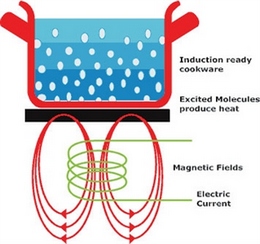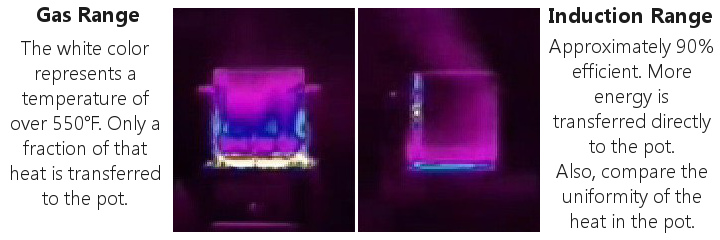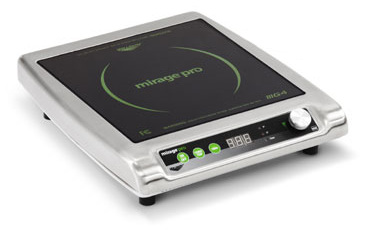So far in this series, we have talked about nonstick cookware and also the different types of aluminum and stainless steel cookware. We now turn our attention to a special category: induction cookware. Here, we will discuss what exactly induction cooking is, how it works, and the specifics of induction-ready cookware.
What is Induction Cooking?

Induction cooking diagram. Image courtesy of Vollrath.
Induction cooking works through electromagnetism. Electricity is sent through an induction coil that generates a magnetic field just above the cooking surface. When induction-ready cookware is placed on the cooktop, the magnetic field rapidly vibrates the molecules in the cookware, heating the pan. It is important to note that it is only the cookware and not the cooktop surface being heated. Since the tempered ceramic or glass cooking surface is unaffected by the magnetic field, it stays cool to the touch.
However, you can’t use just any cookware on induction cooktops. So what makes cookware induction-ready? To put it simply, for cookware to be induction-ready, it needs to be ferrous, which means it needs to be made of materials with strong magnetic properties. Therefore, when cooking with induction, cast iron, and stainless steel are going to be the metals you want to use.
Cast iron has strong magnetic qualities so in most cases, you can count on your cast iron cookware to be induction ready. We say ‘in most cases’ because there are other factors (which are addressed below) that can affect the induction readiness of your cookware.
When it comes to stainless steel, it is important not to assume that all stainless steel is induction ready, because not all stainless steel alloys are made with the same concentration of elements. At the very least, the composition of stainless steel is iron mixed with at least 10.5% chromium. Other elements like carbon and nickel are added, and it is the concentration of these other elements that can give stainless steel different properties. In order for stainless steel to be ferrous, and thus, induction-ready, it needs to have a high enough concentration of nickel. Not all stainless steel has this high concentration of nickel.
But what about aluminum? As you may know, aluminum is non-ferrous. If you try to use your aluminum cookware on an induction cooktop, it will not heat up. However, there is one exception to this rule. In our previous blog post, we discussed clad cookware. Aluminum that is clad with stainless steel can be induction capable, so long as the steel itself is ferrous.
So how can one be sure if a particular piece of cookware is induction ready? There are two ways you can tell. First, be on the lookout for the words ‘induction-ready’ on the labeling or packaging of the cookware. Second, if you are still unsure, you can use a magnet. If a magnet sticks to the cookware, you can be sure it is induction-capable.
Still, other factors can affect the performance of induction cookware. Induction cooktops feature flat surfaces and work well with cookware that is flat-bottomed. Remember that the magnetic field on an induction cooktop is generated just above the cooktop surface. A flat bottom optimizes the cookware’s contact with the magnetic field. A common feature of induction-ready cookware is the addition of a heavy, highly ferrous flat bottom which is impact-bonded to the bottom of the pan.
Advantages and Disadvantages
There are many advantages to induction cooking. Induction cooking is an effective solution in situations where open-flame cooking is not as practical, or where a source of natural gas or propane may not be available, such as mobile kitchens, food trucks, or off-site catering. With the absence of an open flame, induction cooking will not dramatically increase the temperature in the kitchen when compared to a gas stove. This means your ventilation and refrigeration systems will not have to work as hard, saving on energy consumption and costs.
Speaking of energy, induction cooking is more energy-efficient than both gas and conventional electric equipment. This is because of the principals of heat transfer and conservation. Because induction cooking heats only the pan and not the cooking surface, about 90% of the energy an induction cooktop uses is transferred directly to the pan. Compare that to conventional electric where about 65% of the heat generated is transferred to the pan or to gas where it is only about 55%.

Gas Range vs Induction Range. Images courtesy of Vollrath.
Yet another advantage of the absence of an open flame is safety. The induction will not generate heat alone. It must have an induction-ready pan in contact with the cooking surface to work. As soon as the pan is removed, the heat generation ceases. If you accidentally leave your gas or electric stove on and walk away, you have an open heat source that poses a safety hazard and at the same time, is wasting energy. Not so with induction. Even the cooking surface leaves little to no residual heat once the pan is removed because only the pan is heated.
Induction cooktops are much easier to clean than gas or conventional electric stoves. There are no large grates or coils that can catch foodstuff or must be removed for cleaning; just a smooth cooking surface made of either tempered ceramic or glass. It can also be cleaned immediately without having to wait for the surface to cool.
Finally, induction cooking can save time. This is due in part to the 90% energy efficiency we already mentioned. When you add to that the rapid vibration of the molecules inside the pan, it makes for quick heat generation. On average, induction cooktops can bring a pot of water from room temperature to a rapid boil in less than three minutes. Who says a watched pot never boils? Whoever did apparently was not using an induction cooktop!
There are two potential disadvantages to induction cooking. First, the need for flat-bottomed cookware eliminates the possibility of using cookware with rounded bottoms such as a wok. In order to use a wok for induction cooking, you would need to purchase a concave induction range, as well as the appropriate size wok to fit the concave surface. That may be the right solution for some kitchens but you can imagine how limited the application would be. Second, there is a bit of a learning curve involved. Induction cooking has been around a lot longer in European kitchens, but it is still a relatively new trend in the United States. While the rapid heating capability may be desirable, it may take some getting used to. It also takes some time to adjust to the fact that the heating process is interrupted as soon as the pan is lifted from the cooking surface. While this may be an advantage for safety and energy conservation as we mentioned above, it can be a disadvantage at the same time when it comes to cooking techniques such as sautéing or stir-frying where the pan needs to be lifted from the cooking surface. That’s not to say it can’t be done. The heating process will resume immediately as soon as the pan is returned to the surface. It just takes some getting used to.
Market Trends
Induction cooking is still a relatively new trend in the U.S. foodservice industry. Many restaurateurs simply haven’t seen an induction cooktop in action yet and fear of the unknown typically leads to slow adoption. However, there are some current trends that are causing induction to become more popular. Restaurant owners and operators are all too familiar with the ever-rising costs of doing business. As overheard increases, they are looking for new and innovative ways to save money. When you consider the fact that a 2.5-kilowatt induction burner puts out the equivalent cooking power of a 20,000 BTU gas burner, and does so with nearly 45% more efficiency in terms of heat conservation, you can see why an induction range would be a valuable investment.
Environmental concerns also continue to be a driving force in many industries today, and the foodservice industry is no exception. Within our industry, one of the most visible ways we see this trend is the push to adopt more environmentally friendly refrigerants. Another way we see this is the increased proliferation of ENERGY STAR rated kitchen equipment. With their high energy efficiency, you can look for induction cooktops to become a bigger piece of the environment puzzle in the near future.
Another scenario where induction has been well received is in open kitchens, where the kitchen itself is in full view of the customer. The open kitchen concept has increasingly gained traction in recent years. Induction cooktops are desirable in this setting for their sleek appearance, their efficiency, and the fact that they are easy to keep clean.
Care
One of the greatest appeals of induction cookware and ranges is that they are easy to care for. For induction cookware, click here to read part two of this blog series, and follow the instructions for stainless steel cookware.

Simple maintenance will keep your induction range looking great and running at peak efficiency.
For induction ranges, a few simple steps will keep your unit working at peak efficiency. First, always keep induction ranges free from leftover foodstuff or grease. This will prevent anything from interfering between the contact surfaces of the pan and the cooktop. Second, it is important to note that while the cooking surface of an induction range will remain cool to the touch even while cooking, prolonged cooking or leaving hot cookware on the cooktop can still transfer residual heat from the pan to the tempered ceramic or glass surface. In most instances, the cooktop will be cool enough to touch with your bare hand immediately after cooking, but it is best not to assume that this is always to the case. Always double-check to make sure the cooking surface is completely cool before cleaning. This will prevent unintentional damage to the surface. Finally, induction ranges have an air intake, air exhaust, and a fan. All three of these need to be cleaned regularly to ensure that the internal components stay cool and work efficiently.
For cleaning the cooktop surface, Bar Keeper’s Friend produces a soft liquid cooktop cleaner that is great for induction ranges. It is safe and effective on both cool and warm surfaces and won’t scratch the surface of your range.
Where to Find Induction Equipment
You can find a great selection of induction-ready cookware and portable induction ranges in our store at 3110 Preston Highway in Louisville, KY or in our online store (click here for induction cookware or click here for induction ranges). Induction ranges come in many different sizes and configurations, from portable units all the way up to full-size, multi-burner ranges. If you are interested in learning more, please call us at 800-467-6631 and ask to speak to a customer care associate.

